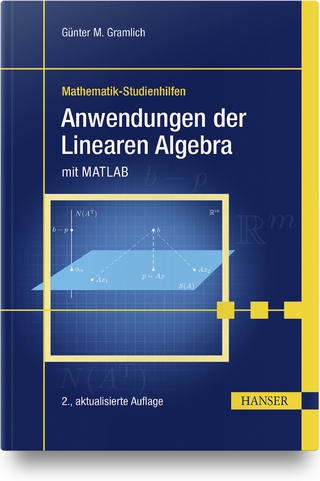
Beginning Algebra
Brooks/Cole (Verlag)
978-0-534-41938-7 (ISBN)
- Titel erscheint in neuer Auflage
- Artikel merken
First, they emphasize strong algebra skills. These skills support the applications and enhance student comprehension.
Second, the authors integrate applications, drawing on realistic data to show students why they need to know and how to apply math. The applications help students develop the skills needed to explain the meaning of answers in the context of the application.
Third, the authors develop key concepts as students progress through the course. For example, the distributive property is introduced in real numbers, covered when students are learning how to multiply a polynomial by a constant, and finally when students learn how to multiply a polynomial by a monomial. These concepts are reinforced through applications in the text.
Last, the authors' approach prepares students for intermediate algebra by including an introduction to material such as functions and interval notation as well as the last chapter that covers linear and quadratic modeling.
Mark Clark graduated from California State University, Long Beach, and holds bachelor's and master's degrees in Mathematics. A full-time associate professor at Palomar College, since 1996, Mark is committed to teaching using applications and technology to help students understand mathematics in context and communicate results clearly. Intermediate algebra is one of his favorite courses to teach and he continues to teach several sections of this course each year. He is co-author of BEGINNING ALGEBRA: CONNECTING CONCEPTS THROUGH APPLICATIONS, INTERMEDIATE ALGEBRA: CONNECTING CONCEPTS THROUGH APPLICATIONS, and BEGINNING AND INTERMEDIATE ALGEBRA: CONNECTING CONCEPTS THROUGH APPLICATIONS published by Cengage. Mark shares his passion for using applications to teach mathematical concepts by delivering workshops and talks to other instructors at local and national conferences. Cynthia (Cindy) Anfinson graduated from UCSD's Revelle College in 1985, summa cum laude, with a Bachelor of Arts Degree in Mathematics and is a member of Phi Beta Kappa. She went to graduate school at Cornell University under the Army Science and Technology Graduate Fellowship. She graduated from Cornell in 1989 with a Master of Science Degree in Applied Mathematics. She is currently an Associate Professor of Mathematics at Palomar College and has been teaching there since 1995. Cindy Anfinson was a finalist in Palomar College's 2002 Distinguished Faculty Award.
R. REVIEW OF PREALGEBRA.
Operations with Integers. Natural Numbers, Whole Numbers, and Integers. Number Lines. Relations between Numbers. Absolute Value. Opposite of a Number. Operations with Integers. Order of Operations. Operations with Fractions. Prime Numbers and Prime Factorization. Reducing Fractions and Equivalent Fractions. Number Lines. Addition and Subtraction. Multiplication and Division. Order of Operations. Operations with Decimals and Percents. Place Value. Relationships between Fractions and Decimals. Number Lines. Addition and Subtraction. Multiplication and Division. Order of Operations. Rounding. Percents. The Real Number System. Rational Numbers. Irrational Numbers. The Real Number System. Distinguish between Exact and Approximate Answers.
1. BUILDING BLOCKS OF ALGEBRA.
Exponents, Order of Operations, and Properties of Real Numbers. Exponents. Introduction to Scientific Notation. Order of Operations. Properties of Real Numbers. Algebra and Working with Variables. Constants and Variables. Evaluating Expressions. Unit Conversions. Defining Variables. Translating Sentences into Expressions. Generating Expressions from Input-Output Tables. Simplifying Expressions. Like Terms. Addition and Subtraction Properties. Multiplication and Distributive Properties. Simplifying Expressions. Graphs and the Rectangular Coordinate System. Data Tables. Bar Graphs and Scatterplots. The Rectangular Coordinate System. Conceptual Understanding of Scale and Applications of Real Life Data.
2. LINEAR EQUATIONS AND INEQUALITIES WITH ONE VARIABLE.
Addition and Subtraction Properties of Equality. Introduction to Equations and Their Solutions. Addition and Subtraction Properties of Equality. Solving Literal Equations. Multiplication and Division Properties of Equality. Multiplication and Division Properties of Equality. Solving Multiple-Step Equations. Generating Equations from Applications. More on Solving Literal Equations. Solving Equations with Variables on Both Sides. Solving Equations that Contain Fractions. Equations that are Identities or Have No Solution. Translating Sentences into Equations and Solving. Solving and Graphing Linear Inequalities on a Number Line. Introduction to Inequalities. Solving Inequalities. Interval Notation and Number Lines. Compound Inequalities.
3. LINEAR EQUATIONS WITH TWO VARIABLES.
Graphing Equations with Two Variables. Using Tables to Represent Ordered Pairs and Data. Graphing Equations by Plotting Points. Vertical and Horizontal Lines. Finding and Interpreting Slope. Interpreting Graphs. Determining a Rate of Change. Calculating Slope. Interpreting Slope. Slope Intercept Form of Lines. Finding and Interpreting Intercepts from Graphs. Finding and Interpreting Intercepts from Equations. Slope Intercept Form of a Line. Linear Equations and Their Graphs. Graphing from Slope-Intercept Form. Graphing from General Form. Recognizing a Linear Equation. Parallel and Perpendicular Lines. Finding Equations of Lines. Finding Equations of Lines Using Slope-Intercept Form. Finding Equations of Lines from Applications. Finding Equations of Lines Using Point-Slope Form. The Basics of Functions. Relations. Functions. Vertical Line Test. Function Notation. Evaluating Functions.
4. SYSTEMS OF LINEAR EQUATIONS.
Identifying Systems of Linear Equations. Introduction to Systems of Equations. Solutions to Systems of Equations. Solving Systems of Equations Graphically. Types of Systems. Solving Systems Using the Substitution Method. Substitution Method. Inconsistent and Dependent Systems. Practical Applications of Systems of Linear Equations. Solving Systems Using the Elimination Method. Elimination Method. More Practical Applications of Systems of Linear Equations. Substitution or Elimination? Solving Linear Inequalities in Two Variables Graphically. Linear Inequalities in Two Variables. Graphing Vertical and Horizontal Inequalities. Systems of Linear Inequalities. Systems of Linear Inequalities.
5. EXPONENTS AND POLYNOMIALS.
Rules for Exponents. Product Rule for Exponents. Quotient Rule for Exponents. Power Rule for Exponents. Powers of Products and Quotients. Negative Exponents and Scientific Notation. Negative Exponents. Using Scientific Notation in Calculations. Introduction to Polynomials. The Terminology of Polynomials. Adding and Subtracting Polynomials. Multiplication of Polynomials. Multiplying Polynomials. FOIL A Handy Acronym. Special Products. Dividing Polynomials. Dividing a Polynomial by a Monomial. Dividing a Polynomial by a Polynomial Using Long Division.
6. FACTORING AND QUADRATIC EQUATIONS.
What It Means to Factor. Finding the GCF. Factoring Out the GCF. Factoring by Grouping. Factor Completely. Factoring Trinomials. Factoring Trinomials of the Form x2+bx+c by Inspection. Factoring Trinomials of the Form ax2+bx+c. Factor Completely. Factoring Special Forms. Difference of Squares. Perfect Square Trinomials. Factor Completely. Solving Quadratic Equations by Factoring. Recognizing a Quadratic Equation. Zero-Product Property. Solving Quadratic Equations by Factoring. Graphing Quadratic Equations. Graphing Quadratic Equations by Plotting Points. The Meaning of a." The Vertex. The Axis of Symmetry. Graphing Quadratic Equations including Intercepts. Finding Intercepts. Sketching a Graph (Pulling It All Together).
7. RATIONAL EXPRESSIONS AND EQUATIONS.
The Basics of Rational Expressions and Equations. Evaluating Rational Expressions and Equations. Excluded Values. Graphing Rational Equations in Two Variables. Simplifying Rational Expressions. Multiplication and Division of Rational Expressions. Multiplying Rational Expressions. Revisiting Unit Conversions. Dividing Rational Expressions. Fundamental Complex Fractions. Addition and Subtraction of Rational Expressions. Adding and Subtracting Rational Expressions with Common Denominators. The Least Common Denominator (LCD). Adding and Subtracting Rational Expressions with Unlike Denominators. More Complicated Complex Fractions. Solving Rational Equations. Shared Work Problems. Proportions, Similar Triangles and Variation. Proportions. Similar Triangles. Variation.
8. RADICAL EXPRESSIONS AND EQUATIONS.
From Squaring a Number to Roots and Radicals. Square Roots. Higher Order Roots. Simplifying Radical Expressions. Basic Operations with Radical Expressions. Simplifying More Complicated Radical Expressions. Adding and Subtracting Radical Expressions. Multiplying and Dividing Radical Expressions. Multiplying Radical Expressions. Dividing Radical Expressions. Rationalizing the Denominator. Solving Radical Equations. Solutions to Radical Equations. Solving Radical Equations. The Distance Formula and Other Applications. Solving Quadratic Equations Using the Square-Root Property. The Pythagorean Theorem and Other Applications. Solving Quadratic Equations by Completing the Square and Quadratic Formula. Solving Quadratic Equations by Completing the Square. Solving Quadratic Equations using the Quadratic Formula.
9. MODELING DATA.
Modeling Linear Data. Finding an "Eye-Ball Best Fit" Linear Model for Real Data. Finding a Linear Model. Using Linear Models to Make Estimates. Model Breakdown. Working with Quadratic Models. Determine If the Data Is Quadratic. Using Quadratic Models to Make Estimates. Model Breakdown.
Appendices.
Geometry Formulas.
Unit Conversions.
Answers to Odd Problems.
Answers to Example Practice Problems."
| Erscheint lt. Verlag | 1.1.2011 |
|---|---|
| Verlagsort | CA |
| Sprache | englisch |
| Gewicht | 1700 g |
| Themenwelt | Mathematik / Informatik ► Mathematik ► Algebra |
| ISBN-10 | 0-534-41938-0 / 0534419380 |
| ISBN-13 | 978-0-534-41938-7 / 9780534419387 |
| Zustand | Neuware |
| Haben Sie eine Frage zum Produkt? |
aus dem Bereich



